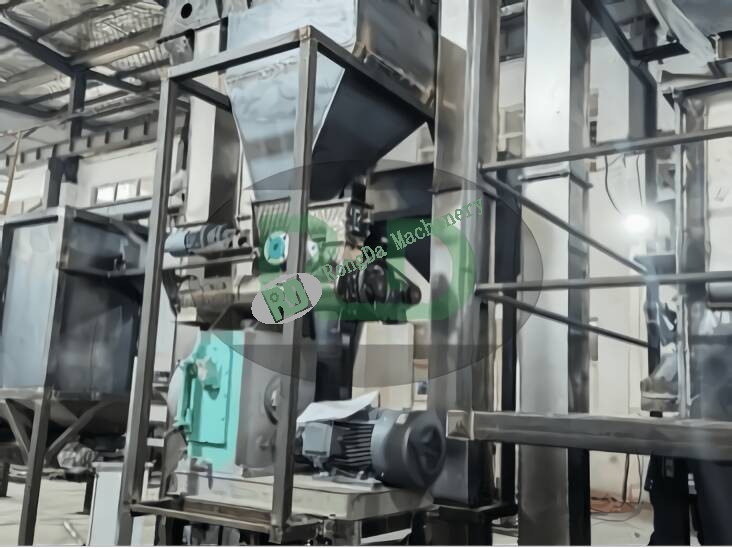Welcome to Rongda Machinery Co., Ltd
Toggle Navigation

Hey there, if you're running a farm or just handling a few animals at home, you know feeding them right can make or break your day. That's where animal feed machines come in—they're game-changers for keeping things running smooth. In this guide, we'll dive into what these gadgets are all about, why they're worth your time, and how to pick one that fits your setup. I'll keep it straightforward, like chatting over coffee, so you can get the info you need without the fluff.
Let's kick things off with the basics. An animal feed machine—sometimes called a feeding machine or feed processing equipment—is basically a tool that helps automate or simplify how you get food to your livestock. Think cows munching on hay, pigs rooting through their grub, or chickens pecking away. These devices handle mixing, grinding, and doling out feed in a way that's controlled and hassle-free. Farms big and small use them for everything from daily chores to big operations.
Why bother with them in today's farming world? Well, things move fast out there, and nobody's got time for endless manual work. These machines cut down on the grunt work, slash your labor bills, and make sure your animals get the nutrients they need without skimping. Beyond saving hours, they keep feed quality steady, which means healthier critters and better output—whether that's more milk from your cows or plumper chickens.
Not all animal feed machines are created equal; they've got different flavors depending on what you need. Here's a quick rundown of the popular ones.
Starting with automatic feeders: These are the workhorses for bigger setups. They spit out feed on a schedule, so you don't have to hover around all day. Perfect if you've got a herd where hand-feeding would drive you nuts—think timed releases that keep everyone fed without the chaos.
Then you've got manual feeders, which are like the no-frills cousins. You crank them yourself to portion out the food, making them great for smaller spots or backyard setups with just a handful of animals. Sure, they're not as hands-off, but they're cheap, tough, and a breeze to fix.
Don't forget silage choppers—these bad boys are pros at hacking up and blending silage, that fermented stuff that's a staple for many farms. If silage is your go-to feed, this machine makes sure it's all mixed even, no big lumps, so your animals can digest it easy and stay healthy.
And hay processors? They're all about turning bales of hay into bite-sized bits. If hay's on the menu for your crew, this helps cut down waste and boosts how well they chew it down, leading to less mess and happier bellies.
Switching to ananimal feed machine isn't just a fancy upgrade—it's smart business. For starters, it frees up your schedule big time. Forget slogging through buckets of feed; let the machine handle it while you tackle other farm jobs, like fixing fences or checking on the herd.
Efficiency? Oh yeah, these things nail it. They deliver just the right portions at the perfect moments, keeping your animals in top shape and ramping up their productivity—more eggs, better meat, you name it.
Waste is another big win. Hand-feeding often means spills or leftovers that go uneaten, but machines portion precisely, so nothing gets tossed. That adds up to savings on feed costs over time.
And the best part? Your animals thrive. Consistent, quality feed means fewer health hiccups and stronger output overall. It's like giving them a balanced meal every time, without the guesswork.

Curious about the nuts and bolts? Let's peek under the hood.
Take automatic feeders—they're programmed to drop feed at set times, or even smarter ones use sensors to sense when an animal's close by. It's all about keeping the flow steady without overdoing it.
Silage choppers get down to business by slicing and stirring silage into a nice, even mix. On bigger farms, this prevents digestive troubles and makes sure every bite counts.
For hay processors, it's a straightforward grind: They shred hay into smaller chunks, often mixing it with other stuff for a custom blend that's easy on the gut and cuts back on leftovers.
Shopping for an animal feed machine? Don't just grab the first shiny thing—think it through. Start with your farm's scale: A massive operation needs heavy-duty gear, while a hobby farm might do fine with something compact.
Budget's a biggie too. Prices vary wildly, so crunch the numbers. Cheaper models might tempt you, but splurging on quality often pays off with less downtime and longer life.
Other stuff to weigh: What animals are you feeding? Match the machine to their needs, like silage-focused for dairy cows or hay-heavy for horses. Do some homework—read reviews, talk to other farmers—and you'll land on a winner.
No machine lasts forever without TLC. Make a habit of cleaning yours after every use to dodge build-up that could jam things up. A quick wipe-down goes a long way.
Run into snags? Clogs are common from sticky feed, or parts might wear out over time. Troubleshooting's usually simple: Check for blockages, tighten loose bits, or swap worn components. If you're proactive with servicing—like oiling moving parts—you'll stretch its lifespan and avoid pricey fixes.
Looking ahead, animal feed machines are getting slicker. Smart feeders hooked up to IoT tech let you monitor everything from your phone—adjust portions remotely or get alerts on low feed.
Sustainability's hot too, with eco-friendly models that cut energy use or handle organic waste better. And customizable options? They're popping up more, letting you tweak feeds for specific animal needs.
All said and done, an animal feed machine can transform how you handle feeding, making life easier and your farm more efficient. Whether you're scaling up or just streamlining, give one a shot—you won't look back.

What's the best type for a small farm? Go with manual feeders if you're budget-conscious; they're simple and reliable.
How much do they cost? It ranges from a few hundred bucks for basics to thousands for high-end automatic ones—shop around.
Do they really save money long-term? Absolutely, by cutting waste and labor, they pay for themselves pretty quick.
Can I use them for all animals? Most are versatile, but check specs for your livestock type.
What if it breaks? Basic fixes are DIY, but for big issues, hit up the manufacturer or a local mechanic.